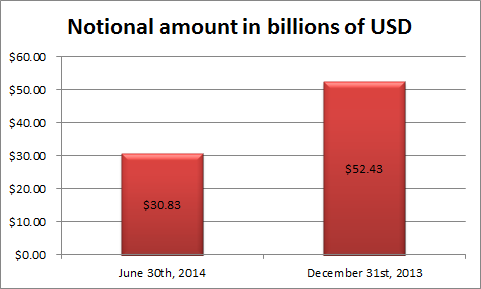Ways to Hedge Interest Rate Risk
Post on: 23 Май, 2015 No Comment

Cap
Borrowers can provide themselves a form of insurance by purchasing a financial derivative called a cap. A party selling a cap agrees to pay the interest on an adjustable-rate loan after the interest rate exceeds a certain percentage. For example, if a borrower purchased a cap at 5 percent and the interest rate rose to 7 percent, the seller of the cap would have to pay two points of interest on the loan.
Collar
A collar is a combination of a floor and a cap that hedges an investor’s bet by insulating her from changes in the interest rate, either up or down. A lender using a cap will generally purchase a floor and sell a cap, while a borrower will sell a floor and purchase a cap. Collars are advantageous because they pay for themselves; however, in exchange, the investor limits the amount of his potential gains.
Swaps
A swap is a financial derivative in which one investor trades payments derived from interest on a loan for another investor’s regular payments of cash. The interest rate payments are generally pegged to an index, while the cash payments are fixed. In this way, an investor can essentially sell profits from the interest rate to another investor, causing him to take on the risks of severe fluctuations. Swaps can also be structured so that one interest rate is traded for another.
Futures
References
More Like This
How to Hedge Against Rising Interest Rates
Interest Rate Hedging Strategies
How to Change Languages in Microsoft Word 2007
You May Also Like
Interest rate risk to a borrower is the risk that rates will rise in the future. Many types of personal and corporate.
In an economic climate where interest rates are near historic lows, when the economy begins to recover, interest rates will eventually start.
Companies use interest rate swaps to manage borrowing when choosing between fixed interest rates and floating interest rates. According to Investopedia, an.
Interest Rate Hedging Strategies. If you owe money at floating rates of interest, you want protection against the costs that a sudden.
Income investments, especially bonds and securities, carry a unique type of risk not associated with most other asset classes. The price of.
As countries increasingly become more interconnected, and cross-border flows of capital, people, goods and services rise, the foreign exchange market, also known.
A financial institution that frequently engages in lending activities, such as a bank, an insurance company or a hedge fund, has to.
Small and large companies often conduct business transactions in one or more foreign currencies. Fluctuations in these currencies represent risks because they.
Commodities markets offer investors the chance to purchase contracts that diversify portfolios and help to limit risk. Although commodities, including items such.














